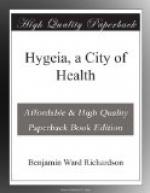The wards are fitted up neatly and elegantly. At one end they open into the corridor, at the other towards a verandah which leads to a garden. In bright weather those sick persons, who are even confined to bed, can, under the direction of the doctor, be wheeled in their beds out into the gardens without leaving the level floor. The wards are warmed by a current of air made to circulate through them by the action of a steam-engine, with which every hospital is supplied, and which performs such a number of useful purposes, that the wonder is, how hospital management could go on without the engine.
If at any time a ward becomes infectious, it is removed from its position and is replaced by a new ward. It is then taken to pieces, disinfected, and laid by ready to replace another that may require temporary ejection.
The hospital is supplied on each side with ordinary baths, hot-air baths, vapour baths, and saline baths.
A day sitting-room is attached to each wing, and every reasonable method is taken for engaging the minds of the sick in agreeable and harmless pastimes.
Two trained nurses attend to each corridor, and connected with the hospital is a school for nurses, under the direction of the medical superintendent and the matron. From this school, nurses are provided for the town; they are not merely efficient for any duty in the vocation in which they are always engaged, either within the hospital or out of it, but from the care with which they attend to their own personal cleanliness, and the plan they pursue of changing every garment on leaving an infectious case, they fail to be the bearers of any communicable disease. To one hospital four medical officers are appointed, each of whom, therefore, has six resident patients under his care. The officers are called simply medical officers, the distinction, now altogether obsolete, between physicians and surgeons being discarded.
The hospital is brought, by an electrical wire, into communication with all the fire-stations, factories, mills, theatres, and other important public places. It has an ambulance always ready to be sent out to bring any injured persons to the institution. The ambulance drives straight into the hospital, where a bed of the same height on silent wheels, so that it can be moved without vibration into a ward, receives the patient.
The kitchens, laundries, and laboratories are in a separate block at the back of the institution, but are connected with it by the central corridor. The kitchen and laundries are at the top of this building, the laboratories below. The disinfecting-room is close to the engine-room, and superheated steam, which the engine supplies, is used for disinfection.




